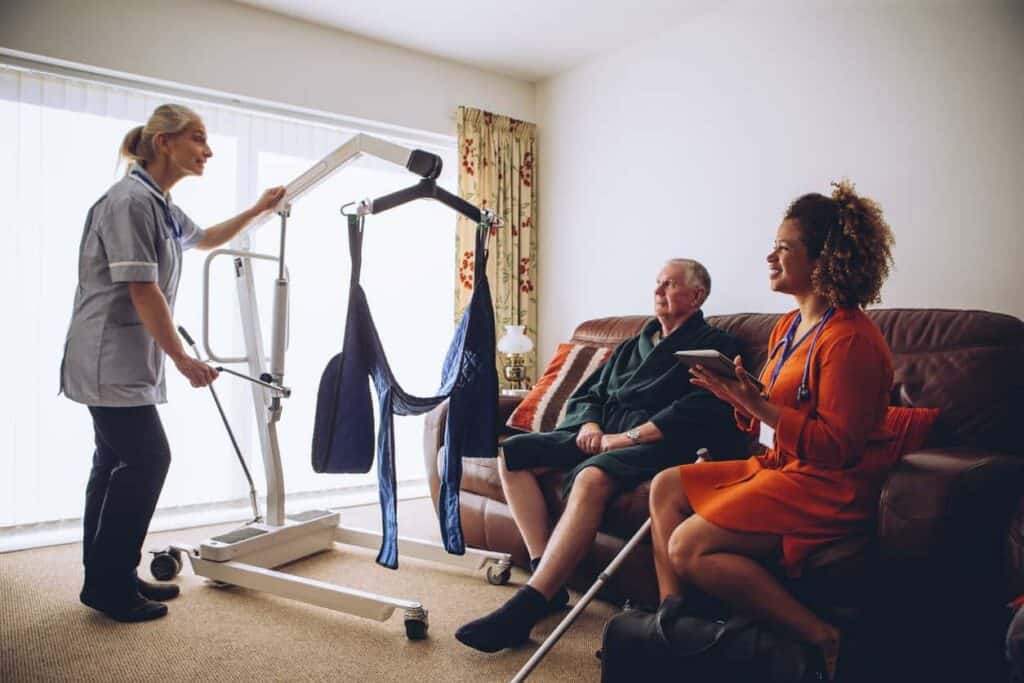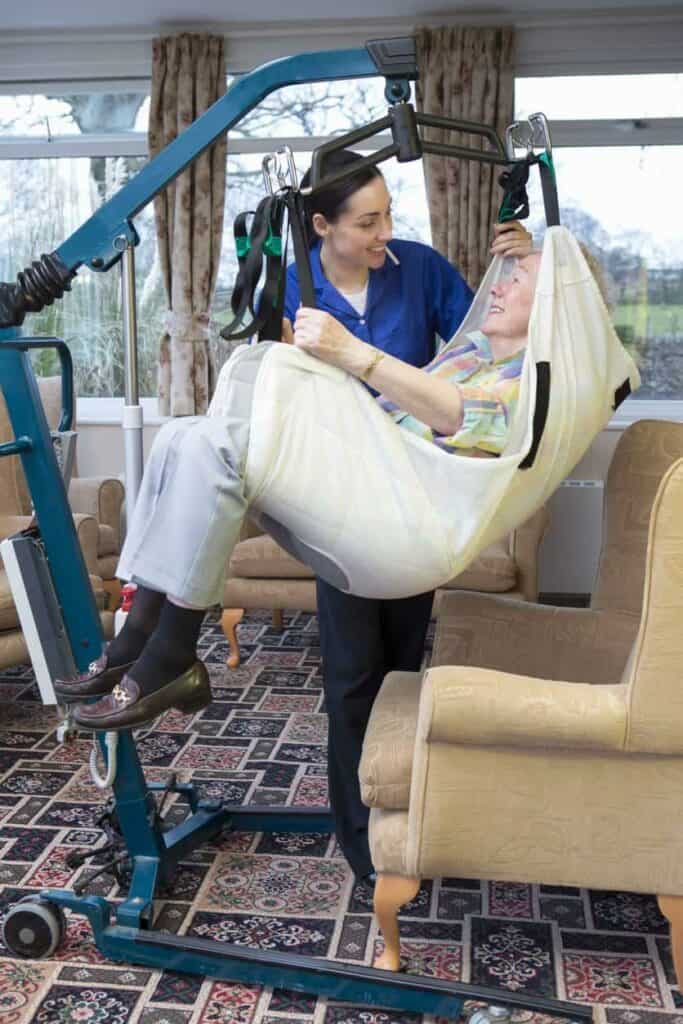brandkit
Brand Kit Brand Kit Brand Colors #CC2C7C #DC4C5C #020202 #989898 #FFFFFF Logos & Icons Small Logo Download Copy Link Brand Icon Download Copy Link

Have you ever found yourself in a situation where you’re caring for a family member struggling with mobility issues? They require help with basic tasks, such as bathing, getting in and out of bed, or simply navigating their home. Caring for a family relative who cannot move freely on their own is challenging. As their caregiver, the strain of trying to provide care on your own could pose risks — both to you and your loved one.
You might wonder if there’s a safer and more efficient way to assist in such cases. Thankfully, you can use an equipment called a Hoyer lift. It’s a valuable tool that simplifies the process of helping people who struggle with mobility.
Read on to learn what a Hoyer lift is, including its different types, benefits, uses, and how it can help promote the safety and well-being of both caregivers and those in their care.
A Hoyer Lift is a mechanical assistive device that comes with a sling designed to lift patients safely. Although “Hoyer” is a brand name, it’s often used as a generic term for any mechanical patient lift type.
Most patient lifts work in a similar way. However, the tools come in different models and types, so you should always check with the manufacturer, owner’s manual, or an expert user to see if yours has various features.
It might be worth investing if you and your loved one can benefit from it. But always familiarize yourself with its proper use — practice with empty slings, then with fully mobile volunteers — before you use it to transfer your loved one with limited mobility.

While there are different types of Hoyer lifts, including manual and powered devices, they do operate in a similar fashion. The manual types include hydraulic cylinders and a hand pump, while the powered consumer lifters use rechargeable battery packs and push-button hand control.
To raise someone using the Hoyer lift, the lifter’s base should be extended to its widest possible position for maximum stability and ground security.
To lower someone using it, release hydraulic pressure safely by turning the knob near the pump handle counterclockwise, but don’t twist it more than one full turn. On the other hand, battery-powered lifters have a button on the hand control for lowering someone.
You must get proper training or education to use the device to avoid any unintentional accidents. User manuals can also give instructions on safety use.
As mentioned, there are different types of Hoyer lifts, including manual and powered equipment. Though they both do the same function of safely moving patients, the latter is more convenient to use.
These types are designed to be operated by hand. It typically has hydraulic assists, which you operate when starting to lift a patient. Using this mobility tool helps ease the physical burden on the caregiver and makes transferring from bed to wheelchair with less effort.
Manual Hoyer lifts are designed with several features that make them a great choice for caregivers:
While a manual Hoyer lift does offer multiple advantages, it’s essential to consider the physical capabilities of the caregiver. Remember that using a manual lift may require more strength and effort than using power-operated lifts.
It’s best to have another family member assist you when moving a loved one using the device. This way, you can operate the tool while the other person ensures your loved one is positioned properly within the sling, ensuring their legs are dangling off the right side of the bed when moving.

A power Hoyer lift, also called an electronic Hoyer lift, makes for a smooth transfer between bed and wheelchair for a person with mobility issues. Typically, power Hoyer lifts are battery-powered and are operated by the touch of a button.
Power Hoyer lifts come with a variety of features that make them a great choice for caregivers. They may come with a higher price tag than manual lifts, but they’re also highly convenient to operate.
While power Hoyer lifts do offer a lot of positive benefits, they can be more expensive compared to manual lifts. Also, caregivers should be properly educated and trained in their proper use to guarantee the safety of everyone involved while using the tool. It also has more controls that you need to memorize.
Both the manual and power versions are versatile and usable in different settings and situations. Here are some common cases where Hoyer lifts can be used:

With the different types of Hoyer lifts available, you must be wondering which one you should choose.
Picking out the right Hoyer lift is an important decision to promote comfort, safety, and overall well-being of both the individual in need of mobility assistance and their caregiver. It requires careful consideration of different factors, from the patient’s mobility needs to cost.
Find out the factors to think through when selecting a Hoyer lift and how consulting a healthcare professional during the buying process is vital.
Listed are some factors to consider when choosing a Hoyer lift.
Assess your loved one’s mobility challenges. Are they partially mobile? Are they completely bedridden? Do they have specific conditions that affect their movement? Then, consider the range of tasks you’ll be using the Hoyer lift for, such as transferring to and from the bed, bathroom, or wheelchair. Also, determine whether you’ll be using the lift to provide additional support for positioning requirements, such as sitting upright or reclining.
More importantly, consider your loved one’s weight and size. This is important to assess the lift’s weight capacity and the appropriate sling size. Make sure that the Hoyer lift you pick can safely accommodate the user.
Evaluate the caregiver’s physical strength and capabilities. Note that manual Hoyer lifts may require more strength and effort, while power Hoyer lifts are motorized and require less physical strength. Gauge the comfort of the caregiver while operating the lift. Features like easy maneuverability and adjustable handles can vastly improve the caregiver’s overall use experience.
How much does a Hoyer lift cost? Take note that power Hoyer lifts tend to be more expensive compared to manual ones. The average cost of a manual Hoyer lift ranges from $400 to $500, while a powered one costs around $3,000.
Aside from the cost of the lift itself, you should also set a separate budget for its accessories and maintenance. Account for any additional costs for slings and other materials. You should also expect to pay for ongoing maintenance and repair of the tool. Manual Hoyer lifts are typically less costly to maintain than power lifts.
Seeking guidance from experienced suppliers and healthcare professionals can help you obtain expert advice before buying to get the most out of your Hoyer lift. Here are some factors to help you.
Consult with the patient’s physical therapist or physician to determine their specific needs and preferences. These professionals can provide valuable insight into what type of Hoyer lift is best suited according to your loved one’s condition.
An occupational therapist can provide guidance on how you can best integrate the use of a Hoyer lift into your loved one’s daily routine. On top of that, they can recommend any necessary modifications to the patient’s environment to ensure their safety and comfort.
They can provide product information, assist in selecting the right model based on your specific needs, and demonstrate how to use the lift.

When it comes to using Hoyer lifts, the safety of both the patient and caregiver should always be the top priority. While these devices are invaluable for assisting individuals with limited mobility, their safe and proper operation requires education, training, and careful observance of instructions.
Learn the importance of education and training, as well as key reminders for the safe use of Hoyer lifts.
Before using a Hoyer lift, caregivers and healthcare professionals should properly train and educate themselves about its operation. Here’s why this is crucial:
To ensure the safe operation of Hoyer lifts, keep these precautions in mind:
Below are some correct positioning and transfer techniques you have to remember before operating the machine.
Maintenance allows you to spot any cause for concern with your Hoyer lift. Here are some inspection strategies to note about the use of your Hoyer lifts:

Where can you buy a medical Hoyer lift? How much does it cost? Is it covered by insurance or Medicare? Find out how you can get a Hoyer lift to use at home.
You can buy a lift online or walk into any medical supply store. Both have advantages and disadvantages.
Many online retailers, such as eBay, and Amazon, and specialized medical equipment websites offer a wide variety of Hoyer lifts. Shopping online is highly convenient and provides you access to product specifications and customer reviews.
You can also purchase Hoyer lifts from your local medical supply stores or durable medical equipment (DME) suppliers. Visiting a store gives you the opportunity to see the lifts in person, ask questions about specifications, and receive guidance from knowledgeable staff.
In some cases, Medicare may cover the cost of a Hoyer lift when it’s prescribed by a healthcare professional. However, coverage and eligibility may vary, so check with Medicare and your healthcare provider for specific details.
If you have a private health insurance plan, check your policy or contact your insurance provider to inquire if they cover the cost of purchase for a Hoyer lift. Some plans offer coverage while others don’t.

As the mechanical Hoyer lift is costly, some families may prefer to buy a used lift. This decision comes with upsides and downsides.
New Hoyer lifts have warranties, ensuring the equipment’s reliability. Any repair requests during the warranty period are considered. Prices for new lifts vary depending on the type, whether manual or power, brand, weight capacity, and other essential features. Cost can range from a few hundred to several thousand dollars.
In contrast, used lifts are more affordable than new ones. You may find a Hoyer lift for sale through local classified ads, online marketplaces, or medical equipment resale stores. When buying used lifts, determine factors like the lift’s age, condition, and whether it still includes all necessary accessories.
Hoyer lifts require several accessories, such as slings and spreader bars. Slings are a necessary part of the device, so you should account for its cost. Also, various slings are designed for different transfer tasks, creating the need for multiple sling types. Some Hoyer lifts also offer optional upgrades, such as scales, specialized slings, or additional safety features, which can add to the overall cost.

Hoyer lifts are valuable mobility aids that provide a range of benefits to both family caregivers and their loved ones. Here are some of its key benefits:
Hoyer lifts are game-changers in caregiving, especially for people with mobility challenges who need assistance in getting in and out of bed. These assistive devices increase mobility, enhance safety, and reduce the strain on both patients and caregivers. Choosing the right Hoyer lift is crucial, and consulting a healthcare professional adds a layer of expertise to your decision-making.
Besides assistive aids, we at Amy’s Eden also recognize that caregivers are an important part of high-quality care. If you need a dependable caregiver to help you operate a Hoyer lift, increase your loved one’s mobility by transferring them to other home areas whenever they want, and provide them with companionship care — we’re ready to help. Reach out to us and get to know our caregivers, explore our services, or take a virtual tour of one of our homes.
Get care >
Brand Kit Brand Kit Brand Colors #CC2C7C #DC4C5C #020202 #989898 #FFFFFF Logos & Icons Small Logo Download Copy Link Brand Icon Download Copy Link

Are you worried your loved one isn’t sleeping well? Do you notice them tossing and turning, napping in the afternoon, or complaining about fatigue most

There’s something deeply comforting about aging in a place that feels like home—the familiar walls, the cherished memories, the sense of belonging. For many older

Caring for an elderly loved one is a journey filled with love, challenges, and a lot of questions. One of the biggest questions you might

Amy's Eden Senior Care © 2023
